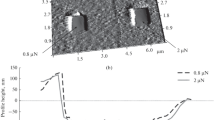Abstract
In the present work we demonstrate the development of a thin layer activation (TLA) method to be able to measure micrometer wear or less by using radioactive tracing. In order to activate very swallow depths we decreased the bombarding energy to the “linear” region of the cross-section curve. The disadvantage of the method is that the wear curve will be “linear” near to the surface instead of “constant” as is the case with the usual (high energy) TLA. The advantage is that the activity of the sample will be much lower and it is concentrated in the swallower studied depth. The other possible method is irradiation under small angle (15 to 30° or even grazing incidence), which also causes a near-surface concentration of the activity produced. Both methods are demonstrated with the most suitable nuclear reactions and some commonly used industrial materials.









Similar content being viewed by others
References
Ditrói F, Takács S, Tárkányi F, Reichel M, Scherge M, Gerve A (2006) Thin layer activation of large areas for wear study. Wear 261(11–12):1397–1400. doi:10.1016/j.wear.2006.03.049
Ditrói F, Fehsenfeld P, Khanna AS, Konstantinov I, Majhunka I, Racolta PM, Sauvage T, Thereska J (1997) The thin layer activation method and its applications in industry. IAEA TECDOC, vol 924. Vienna
Huang DH, Wang PS, Tian WZ, Zhao DQ, Cao GZ, Ni BF, Zhang XH, Li L, Zhang GY, Liu CX, Li DH (2008) Study on real-time wear measurement of piston-ring and cylinder-bore in an engine using thin layer activation method. Appl Radiat Isot 66(8):1073–1078. doi:10.1016/j.apradiso.2007.11.014
Corniani E, Jech M, Ditrói F, Wopelka T, Franek F (2009) TLA and wear quantification of an aluminium–silicon–copper alloy for the car industry. Wear 267(5–8):828–832. doi:10.1016/j.wear.2009.02.007
Tárkányi F, Hermanne A, Takács S, Ditrói F, Dityuk AI, Shubin YN (2004) Excitation functions for production of radioisotopes of niobium, zirconium and yttrium by irradiation of zirconium with deuterons. Nucl Instrum Methods B 217(3):373–388. doi:10.1016/j.nimb.2003.11.084
Vasvary L, Ditrói F, Takács S, Szabo Z, Szucs J, Kundrak J, Mahunka I (1994) Wear measurement of the cutting edge of superhard turning tools using TLA technique. Nucl Instrum Methods B 85(1–4):255–259
Tárkányi F, Takács S, Szelecsényi F, Ditrói F, Hermanne A, Sonck M (2003) Excitation functions of deuteron induced nuclear reactions on natural tungsten up to 50 MeV. Nucl Instrum Methods B 211(3):319–330. doi:10.1016/S0168-583x(03)01389-2
Tárkányi F, Ditrói F, Szelecsényi F, Sonck M, Hermanne A (2002) Measurement and evaluation of the excitation functions for alpha particle induced nuclear reactions on niobium. Nucl Instrum Methods B 198(1–2):11–31
Ditrói F, Takács S, Tárkányi F, Mahunka I (1995) Study of the C-nat(He-3,2 alpha)Be-7 and Be-9(He-3, alpha n)Be-7 nuclear reactions and their applications for wear measurements. Nucl Instrum Methods B 103(4):412–414
Ditrói F, Mahunka I (1996) Thin layer activation of non-metallic materials by using nuclear implantation. Nucl Instrum Methods B 113(1–4):415–419
Ditrói F, Mahunka I (1998) Investigation of the recoil implantation for thin layer activation and wear measurements. Wear 219(1):78–83
Hoffmann M, Abbas K, Sauvage T, Blondiaux G, Vincent L, Stroosnijder MF (2001) (7)Be recoil implantation for ultra-thin-layer-activation of medical grade polyethylene: effect on wear resistance. Nucl Instrum Methods B 183(3–4):419–424
Baron N, Cohen BL (1963) Activation cross-section survey of deuteron-induced reactions. Phys Rev 129:2636
Nuclear Data Section IAEA Exfor Database. IAEA. http://www-nds.iaea.or.at/exfor/exfor.htm
Andersen HH, Ziegler JF (1977) Hydrogen: stopping powers and ranges in all elements. The stopping and ranges of ions in matter, vol 3. Pergamon Press, New York
Fehsenfeld P, Kleinrahm A, Schweickert H (1992) Radionuclide technique in mechanical-engineering in Germany. J Radioanal Nucl Chem 160(1):141–151
Konstantinov IO, Leonov AI, Mikheev VI (1990) Surface activation for wear profile studies of piston rings. Wear 141(1):17–22
Ekström LP, Firestone RB. WWW Table of Radioactive Isotopes, database version 2/28/99 from URL http://ie.lbl.gov/toi/index.htm
European-Commission (1996) Basic safety standards for the protection of the health of workers and the general public. Off J Eur Comm OJ L159:p19
Acknowledgment
This work was partly supported by EU Marie-Curie MRTN-CT-2006-035589 WEMESURF project.
Author information
Authors and Affiliations
Corresponding author
Rights and permissions
About this article
Cite this article
Ditrói, F., Takács, S., Tárkányi, F. et al. Sub-micron wear measurement using activities under the free handling limit. J Radioanal Nucl Chem 292, 1147–1152 (2012). https://doi.org/10.1007/s10967-012-1625-1
Received:
Published:
Issue Date:
DOI: https://doi.org/10.1007/s10967-012-1625-1




